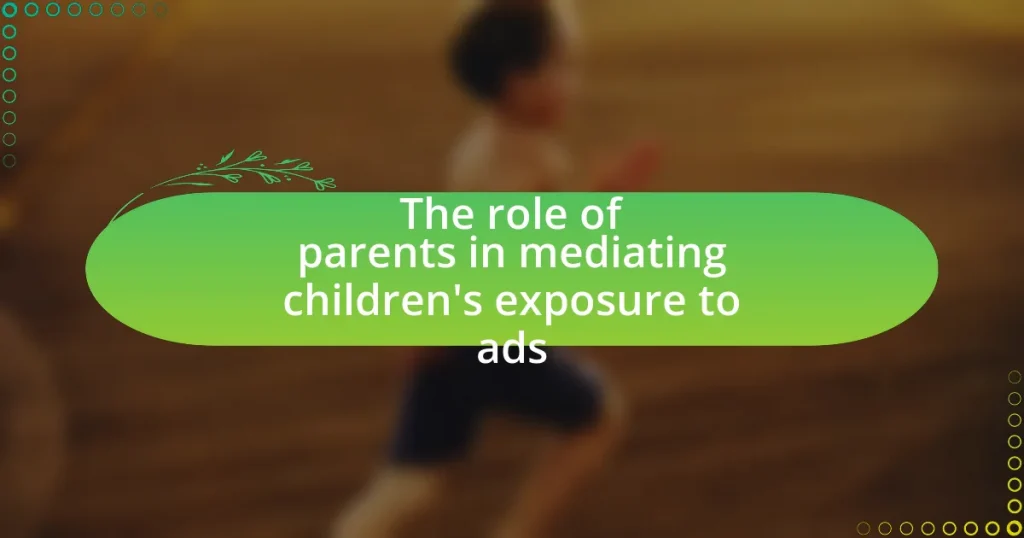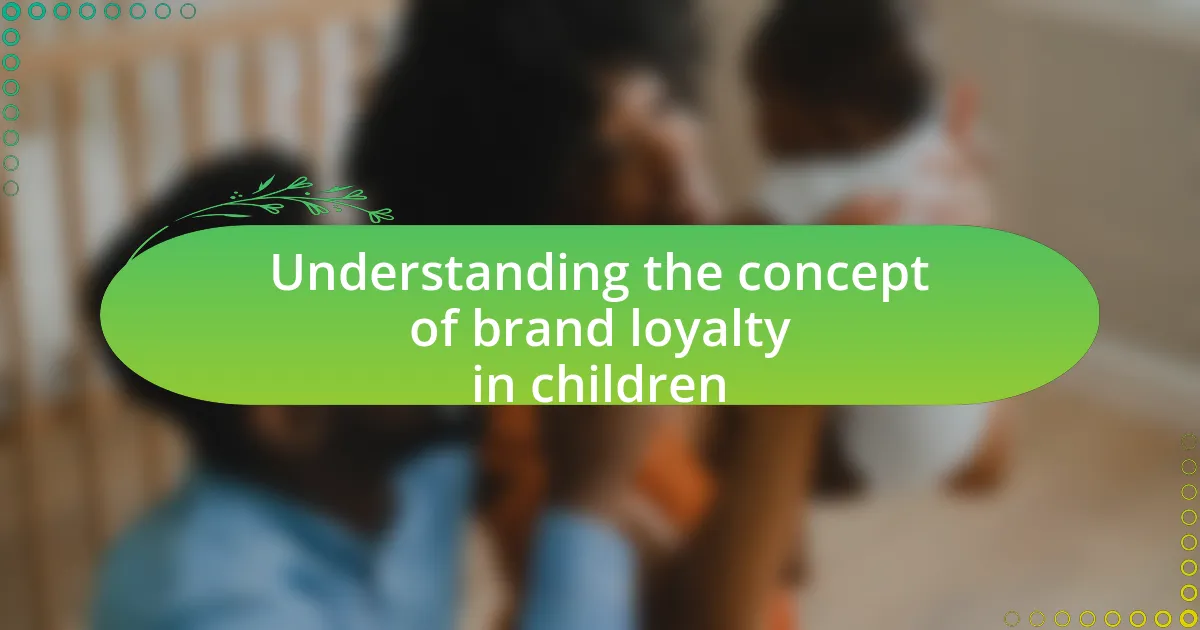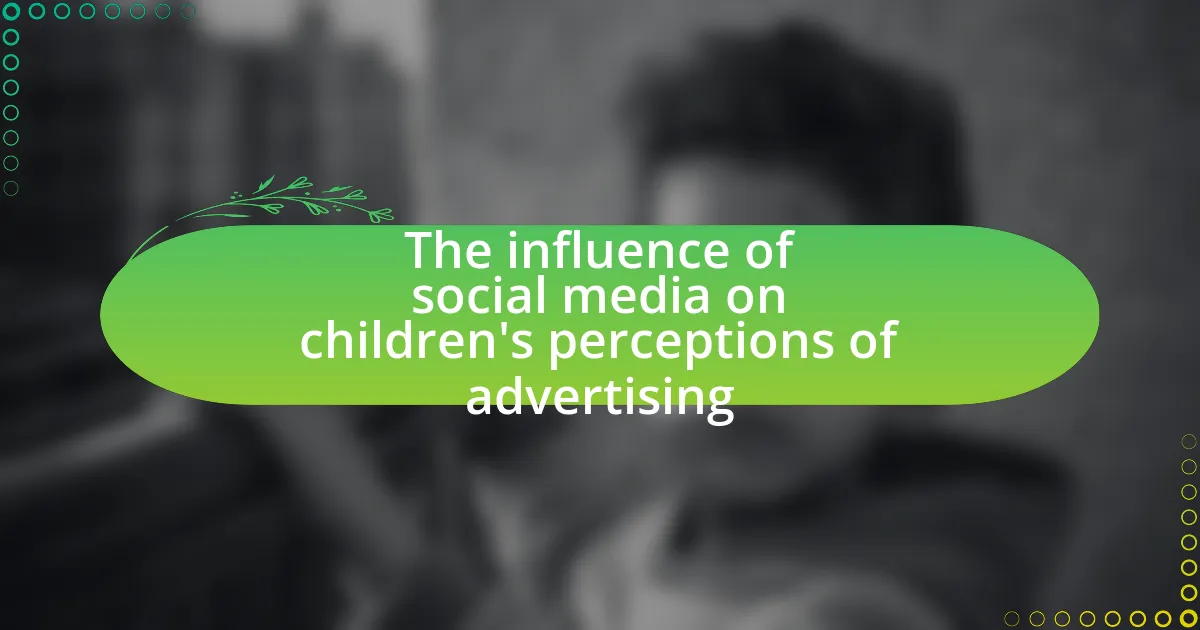The article examines the critical role of parents in mediating children’s exposure to advertisements. It highlights how parental mediation strategies, such as active co-viewing and discussions about advertising intent, can significantly influence children’s perceptions and responses to ads. The article outlines various mediation styles, including active, restrictive, and evaluative mediation, and discusses their impact on children’s media literacy and critical thinking skills. Additionally, it addresses the potential risks of unmediated exposure to ads, such as unhealthy eating habits and materialism, while providing practical tips for parents to effectively manage their children’s media consumption and enhance their understanding of advertising.
What is the role of parents in mediating children’s exposure to ads?
Parents play a crucial role in mediating children’s exposure to advertisements by guiding their understanding and interpretation of marketing messages. They can influence children’s perceptions of ads through discussions about the content, teaching critical thinking skills, and setting limits on media consumption. Research indicates that parental mediation strategies, such as active co-viewing and discussing the intent behind advertisements, can significantly reduce the impact of advertising on children’s materialistic attitudes and unhealthy food choices. For instance, a study published in the Journal of Advertising Research found that children whose parents engaged in active mediation were less likely to develop positive attitudes towards unhealthy food ads.
How do parents influence their children’s perceptions of advertisements?
Parents significantly influence their children’s perceptions of advertisements through direct communication and modeling behaviors. By discussing the content of ads, parents can help children critically evaluate marketing messages, shaping their understanding of advertising intent and persuasive techniques. Research indicates that children who engage in discussions about advertisements with their parents are better equipped to discern the difference between entertainment and marketing, leading to more skeptical attitudes towards ads. For instance, a study published in the Journal of Advertising Research found that parental mediation positively correlates with children’s ability to recognize advertising tactics, enhancing their critical thinking skills regarding media consumption.
What strategies do parents use to discuss ads with their children?
Parents use several strategies to discuss ads with their children, including critical questioning, contextual discussions, and modeling behavior. Critical questioning involves parents asking children what they think about an advertisement, encouraging them to analyze the message and intent behind it. Contextual discussions occur when parents relate ads to real-life situations, helping children understand the implications of advertising in everyday life. Modeling behavior includes parents demonstrating thoughtful consumption by discussing their own media choices and explaining why they may or may not engage with certain products. Research indicates that these strategies can enhance children’s media literacy and critical thinking skills regarding advertisements, fostering a more discerning approach to advertising messages.
How do parental attitudes towards advertising affect children’s responses?
Parental attitudes towards advertising significantly shape children’s responses to ads. When parents express skepticism or critical views about advertising, children are more likely to adopt a similar critical perspective, leading to increased resistance to persuasive messages. Conversely, if parents demonstrate a positive attitude towards advertising, children may be more susceptible to its influence, often viewing ads as credible sources of information. Research by the American Psychological Association indicates that children whose parents actively discuss and critique advertisements are better equipped to understand marketing tactics, resulting in more discerning consumption behaviors. This dynamic illustrates the crucial role parents play in mediating their children’s exposure to advertising and shaping their interpretative frameworks.
Why is parental mediation important in the context of advertising?
Parental mediation is important in the context of advertising because it helps children critically evaluate and understand the persuasive intent behind ads. Research indicates that children are particularly vulnerable to advertising messages, often lacking the cognitive skills to discern between entertainment and marketing. For instance, a study published in the Journal of Consumer Research found that children aged 8 to 12 are more likely to believe that advertisements are truthful compared to adults. By engaging in discussions about advertisements, parents can foster critical thinking skills, enabling children to recognize advertising tactics and make informed choices. This active involvement not only mitigates the potential negative effects of advertising on children’s consumption behaviors but also promotes media literacy, equipping them with the tools to navigate a media-saturated environment effectively.
What are the potential risks of unmediated exposure to ads for children?
Unmediated exposure to ads for children poses several potential risks, including the development of unhealthy eating habits, materialism, and impaired critical thinking skills. Research indicates that children are particularly susceptible to persuasive advertising techniques, which can lead to increased consumption of unhealthy foods and beverages, contributing to childhood obesity. A study published in the journal “Pediatrics” found that children exposed to food advertisements are more likely to choose unhealthy snacks over healthier options. Additionally, unmediated exposure can foster materialistic values, as children may equate happiness with the acquisition of products, leading to dissatisfaction and unrealistic expectations. Furthermore, without parental guidance, children may struggle to critically evaluate advertising messages, making them more vulnerable to manipulation.
How can parental mediation mitigate negative effects of advertising?
Parental mediation can mitigate the negative effects of advertising by actively engaging children in discussions about the content and intent of advertisements. This engagement helps children develop critical thinking skills, enabling them to discern persuasive techniques used in ads. Research indicates that children who experience active mediation, such as parents explaining the purpose of ads and discussing their implications, are less likely to exhibit materialistic attitudes and unhealthy consumption behaviors. For instance, a study published in the Journal of Advertising Research found that children exposed to parental guidance showed a significant reduction in the influence of advertising on their purchasing decisions.
What types of parental mediation exist regarding children’s exposure to ads?
Three main types of parental mediation exist regarding children’s exposure to ads: active mediation, restrictive mediation, and evaluative mediation. Active mediation involves parents discussing advertisements with their children, helping them understand the content and intent behind the ads. Restrictive mediation refers to parents setting limits on the amount of advertising their children can be exposed to, such as controlling screen time or choosing ad-free platforms. Evaluative mediation includes parents guiding children in critically assessing advertisements, teaching them to differentiate between persuasive techniques and factual information. Research indicates that these mediation strategies can significantly influence children’s understanding and response to advertising, shaping their consumer behavior and critical thinking skills.
How do different mediation styles impact children’s understanding of ads?
Different mediation styles significantly impact children’s understanding of ads by shaping their critical thinking and interpretation skills. Active mediation, where parents discuss and analyze advertisements with their children, enhances children’s ability to critically evaluate the content and intent of ads, leading to a more nuanced understanding. In contrast, restrictive mediation, which involves limiting exposure to ads without discussion, may leave children less equipped to discern advertising techniques and messages. Research by Valkenburg and Peter (2011) indicates that children exposed to active mediation demonstrate better comprehension of persuasive intent in advertisements compared to those who experience restrictive mediation. This evidence underscores the importance of parental involvement in fostering critical media literacy among children.
What are the characteristics of active mediation versus restrictive mediation?
Active mediation involves parents engaging in discussions with their children about advertisements, helping them understand and critically evaluate the content. This approach encourages children to ask questions and express their thoughts, fostering media literacy and critical thinking skills. In contrast, restrictive mediation focuses on setting limits on children’s media consumption, such as controlling the amount of time spent watching ads or prohibiting certain types of content altogether. This method aims to shield children from potentially harmful messages but may not equip them with the skills to navigate media independently. Research indicates that active mediation is associated with better outcomes in children’s understanding of advertising, while restrictive mediation may lead to a lack of critical engagement with media.
How does the context of media consumption influence mediation styles?
The context of media consumption significantly influences mediation styles by determining how parents engage with their children’s media experiences. For instance, when children consume media in a shared family environment, parents are more likely to adopt active mediation styles, such as discussing content and its implications, which fosters critical thinking. Conversely, in solitary media consumption contexts, parents may resort to restrictive mediation styles, limiting access to certain content without engaging in dialogue. Research indicates that children exposed to media in interactive settings, like family discussions, develop better media literacy skills compared to those who consume media in isolation, highlighting the importance of context in shaping effective mediation strategies.
What role does parental involvement play in children’s media literacy?
Parental involvement plays a crucial role in enhancing children’s media literacy by guiding their understanding and interpretation of media content. Parents who actively engage in discussions about media messages help children develop critical thinking skills, enabling them to analyze and evaluate advertisements effectively. Research indicates that children with involved parents are more likely to recognize persuasive intent in advertisements and understand the difference between entertainment and marketing. For instance, a study published in the Journal of Advertising Research found that children whose parents discussed media content with them demonstrated improved ability to discern advertising techniques. This involvement not only fosters critical analysis but also empowers children to make informed choices regarding media consumption.
How can parents enhance their children’s critical thinking about ads?
Parents can enhance their children’s critical thinking about ads by engaging them in discussions about advertising techniques and encouraging skepticism. By explaining how ads use persuasive language, imagery, and emotional appeals, parents can help children recognize the intent behind advertisements. Research indicates that children who are taught to analyze ads critically are better equipped to understand marketing strategies and make informed decisions. For instance, a study published in the Journal of Consumer Research found that children exposed to discussions about advertising were more likely to question the credibility of ads and differentiate between entertainment and marketing.
What resources are available for parents to educate their children about advertising?
Parents can utilize various resources to educate their children about advertising, including books, online courses, and educational websites. For instance, books like “The Advertising Effect: How to Change Behaviour” by Adam Ferrier provide insights into advertising strategies and their impact. Online platforms such as Common Sense Media offer guides and articles that help parents discuss media literacy and advertising with their children. Additionally, organizations like the American Psychological Association provide resources and research on the effects of advertising on children, enabling parents to understand and explain these concepts effectively.
How can parents effectively mediate their children’s exposure to ads?
Parents can effectively mediate their children’s exposure to ads by actively engaging in discussions about advertising content and its intent. By explaining the purpose of advertisements and encouraging critical thinking, parents help children understand the persuasive techniques used in marketing. Research indicates that children who receive guidance from parents are better equipped to recognize advertising strategies, leading to more informed consumer behavior. For instance, a study published in the Journal of Consumer Research found that parental mediation significantly reduces the likelihood of children being influenced by ads.
What practical tips can parents use to discuss ads with their children?
Parents can effectively discuss ads with their children by encouraging critical thinking about advertising messages. Engaging children in conversations about the purpose of ads helps them understand that advertisements are designed to persuade consumers to buy products. For instance, parents can ask questions like, “What do you think this ad is trying to sell?” or “How does this ad make you feel?” This approach fosters analytical skills and awareness of marketing tactics.
Additionally, parents can use real-life examples to illustrate how ads can be misleading. Discussing the difference between needs and wants can help children differentiate between essential products and those marketed for emotional appeal. Research indicates that children as young as 8 years old can understand the persuasive intent of ads when guided appropriately (Luna, 2018, Journal of Consumer Research).
Finally, parents should model healthy media consumption habits by limiting screen time and discussing the ads encountered during viewing. This practice not only reinforces the conversation about advertising but also helps children develop a balanced perspective on media influence.
How can parents create a dialogue about advertising in everyday situations?
Parents can create a dialogue about advertising in everyday situations by actively discussing advertisements encountered during daily activities, such as watching TV or shopping. Engaging children in conversations about the intent behind ads helps them understand persuasive techniques and the difference between needs and wants. For instance, when a child sees a commercial, parents can ask questions like, “What do you think this ad is trying to sell?” or “How does this make you feel about the product?” This approach encourages critical thinking and awareness of marketing strategies. Research indicates that children who engage in discussions about advertising with their parents develop better media literacy skills, enabling them to navigate advertising more effectively.
What are some common challenges parents face in mediating ads?
Parents commonly face challenges such as a lack of understanding of advertising techniques, difficulty in discussing the persuasive nature of ads with children, and the overwhelming volume of advertisements children encounter daily. Research indicates that many parents are not fully aware of how ads target children through emotional appeals and branding strategies, making it hard for them to effectively mediate these influences. Additionally, parents often struggle to find the time to engage in meaningful discussions about ads, as children are exposed to a high frequency of advertisements across various media platforms, including television, social media, and online games. This constant exposure complicates parents’ efforts to filter content and instill critical thinking about advertising in their children.
What are the best practices for parents in managing children’s media consumption?
The best practices for parents in managing children’s media consumption include setting clear limits on screen time, actively engaging in co-viewing, and discussing content critically. Research indicates that children who have structured media use are less likely to experience negative effects associated with excessive screen time, such as obesity and sleep disturbances. Additionally, co-viewing allows parents to contextualize advertisements and media messages, fostering critical thinking skills. A study published in the Journal of Pediatrics found that children who engage in discussions about media content with their parents are better equipped to understand and resist advertising influences.
How can parents set appropriate boundaries for ad exposure?
Parents can set appropriate boundaries for ad exposure by establishing clear rules regarding media consumption and actively monitoring the content their children engage with. Research indicates that children are particularly susceptible to advertising messages, with studies showing that they can recognize brands as early as age two. By limiting screen time and selecting age-appropriate programming, parents can reduce the likelihood of their children being exposed to persuasive advertisements. Additionally, discussing the intent behind advertisements and encouraging critical thinking about marketing messages can empower children to understand and question the ads they encounter.
What tools and technologies can assist parents in monitoring ads?
Tools and technologies that assist parents in monitoring ads include ad-blocking software, parental control applications, and content filtering tools. Ad-blocking software, such as AdBlock Plus, prevents ads from displaying on websites, reducing children’s exposure to advertisements. Parental control applications, like Qustodio and Norton Family, allow parents to monitor and restrict the types of content their children can access, including advertisements. Content filtering tools, such as OpenDNS, enable parents to block specific categories of content, including ads, ensuring a safer online environment for children. These technologies provide parents with effective means to manage and limit their children’s exposure to advertising.






